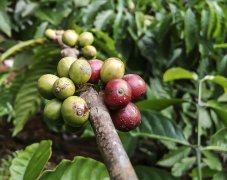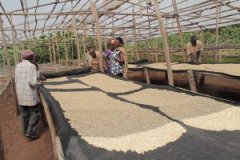Sumatra Manning & #8226; Sumatra Mandheling unique Flavor Origin

For professional baristas, please follow the coffee workshop (Wechat official account cafe_style)
Mantenin in Sumatra has woody tonality and mellow taste and low acidity. The wet peeling method developed due to local environmental conditions has given Sumatra coffee a unique flavor. The most obvious flavors are cedar, cocoa, herbal medicine, fermented fruit and tobacco.
Sumatra Mantenin Sumatra Mandheling-
Unique flavor
The coffee grown in the environmental soil of Sumatra is rich in woody texture and mellow taste, introverted flavor and lively and moderate acidity, as well as unique flavors such as herbal medicine, cedar, cocoa, fermented fruit and so on. Among them, Mantenin is the most classic coffee bean among the coffee beans produced in Indonesia, accounting for only 25% of the Arabica coffee species. It has an excellent classic taste, strong taste, mellow and lively movement, but it is not astringent but not sour, and its mellowness and bitterness can be fully revealed. When tasting Mantenin, it can be lubricated on the tip of the tongue, with a hint of herbaceous aromas, sweet cocoa and fruity aromas, with a long finish. Generally speaking, fans of Manning drink as a single drink, but Manning is also an indispensable variety of mixed coffee.
Introduction of origin
Sumatra is the largest island in Indonesia, located above the equator, with a tropical rain forest climate, high temperature, humidity and abundant rainfall. Small coffee farmers usually grow in primitive mountains, and their water resources are very precious, so a unique "wet peeling" sectional drying method (Giling Basah, Wet hulling) has been developed here, which adds a different flavor to Sumatra coffee from other regions. Of the coffee beans produced in Indonesia, 25 per cent are Arabica and the remaining 75 per cent are Robusta, while fine Arabica coffee from northern Sumatra is sold on the market as Lintong and Mandheling.
Planting history of producing area
In the 17th century, the Dutch introduced Arabica saplings to Java for the first time and gradually expanded to Sumatra and other Indonesian islands. In 1877, a large-scale rust disease hit the Indonesian islands, almost destroying Arabica trees planted at low elevations, and many farmers had to give up Arabica coffee trees that had been operated for many years. Robusta coffee trees with strong disease resistance were introduced from Africa, and only a few Arabica trees were still planted at high elevations, while these remaining Arabica species It is the ancestor of Manning and Lindong Coffee, which are famous for their unique flavor.
Planting altitude
Sumatra Mante can be grown on an average of 1200 meters above sea level on a plateau of 1500 meters above sea level, with abundant rainfall and volcanic soil that contribute to coffee cultivation to produce high-quality Manning coffee beans.
Important Notice :
前街咖啡 FrontStreet Coffee has moved to new addredd:
FrontStreet Coffee Address: 315,Donghua East Road,GuangZhou
Tel:020 38364473
- Prev

SL28, the most famous coffee variety in Kenya, introduces which one is the best in Kenya.
Professional baristas Please follow the Coffee Workshop (Wechat official account cafe_style) "Kenya" in East Africa is one of the major coffee producing countries. More than 6 million people in the country are engaged in the coffee industry, mostly in the form of a combination of small farmers and cooperatives. Coffee trees in Kenya are mostly planted at 1400-2000 meters above sea level, and the growing areas include Ruiri, Thika and K.
- Next

Guatemalan Coffee 2017 Champion Manor-Santa Felisa Manor Sun Huang Kaduai Flavor introduction
For the exchange of professional baristas, please follow the Coffee Workshop (Wechat cafe_style) Guatemala Acatenango Finca Santa Felisa Yellow Catuai Natural Guatemalan Coffee 2017 Champion San Felisa Manor Huang Carduai Sun treatment Flavor description: citrus, sweet dried berries. Citrus, orange juice, plums, strange can be felt at the entrance.
Related
- Detailed explanation of Jadeite planting Land in Panamanian Jadeite Manor introduction to the grading system of Jadeite competitive bidding, Red bid, Green bid and Rose Summer
- Story of Coffee planting in Brenka region of Costa Rica Stonehenge Manor anaerobic heavy honey treatment of flavor mouth
- What's on the barrel of Blue Mountain Coffee beans?
- Can American coffee also pull flowers? How to use hot American style to pull out a good-looking pattern?
- Can you make a cold extract with coffee beans? What is the right proportion for cold-extracted coffee formula?
- Indonesian PWN Gold Mandrine Coffee Origin Features Flavor How to Chong? Mandolin coffee is American.
- A brief introduction to the flavor characteristics of Brazilian yellow bourbon coffee beans
- What is the effect of different water quality on the flavor of cold-extracted coffee? What kind of water is best for brewing coffee?
- Why do you think of Rose Summer whenever you mention Panamanian coffee?
- Introduction to the characteristics of authentic blue mountain coffee bean producing areas? What is the CIB Coffee Authority in Jamaica?

